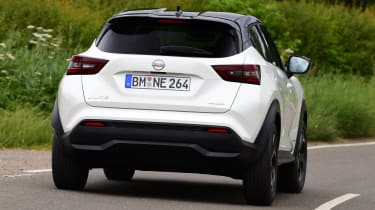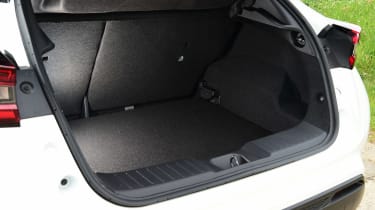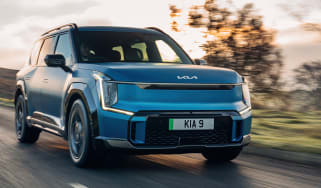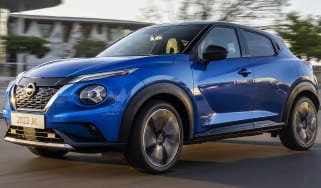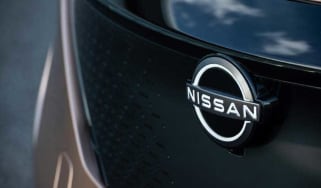Nissan Juke Hybrid review
The Juke Hybrid is probably the best version of the compact SUV yet, but it falls short of more accomplished rivals in more than one area

Pros
- e-Pedal mode
- Quite efficient
- Great around town
Cons
- Rivals even more efficient
- Harsh engine note
- Small boot
| Car type | Fuel economy | CO2 emissions | 0-62mph |
|---|---|---|---|
| Hybrid | 56mpg | 114g/km | 10.1s |
It has been over a decade since Nissan launched the pure-electric Leaf and kickstarted the compact SUV craze with the hugely popular Juke. It’s somewhat surprising, then, that it has taken this long for the Japanese brand to launch a hybrid version of the Juke, but here it is, set to rival the Toyota Yaris Cross, Renault Captur E-TECH, Kia Niro Hybrid and Hyundai Kona Hybrid, among many others.
The Juke Hybrid does share some components with Captur E-TECH, thanks to an alliance between the brands. But its 93bhp 1.6-litre petrol engine and 48bhp electric motor are bespoke, with the latter powered by a relatively small 1.2kWh battery. The 141bhp combined output makes this the most potent model in the Juke family, as well as the most efficient.
Nissan claims the Juke Hybrid can return just over 56mpg fuel economy, while CO2 emissions range from 114 to 115g/km. That compares to just under 59mpg and 104g/km for the latest Kia Niro Hybrid, although the electrified Juke’s figures are at least improvements over the petrol-engined Juke’s 48mpg and 134g/km of CO2. We easily saw high 40s on our test route.
The Juke Hyrbid’s battery may not be that big, but the car always starts in EV mode and can travel at up to 34mph on electric power alone. Be gentle with the accelerator and it’ll get up to speed smoothly without using a drop of fuel. Ask for more acceleration and the petrol engine will support the electric motor, driving the wheels directly. It’ll also act as a generator to keep the battery topped up, meaning the e-motor keeps delivering its maximum 205Nm of torque. There’s also an ‘e-Pedal’ function for increased regenerative braking, which is something the Juke’s Renault sister car doesn’t feature.
The Nissan feels much happier at a relaxed pace, with the electric motor delivering the majority of performance and the combustion engine helping at lower revs. Pushing harder on the throttle and the 1.6-litre’s relatively coarse engine note disrupts refinement.
The Juke is still no corner-carving SUV, but the steering has a good amount of weight, plus the speed on tap is well suited for the amount of grip on offer and the suspension; the car doesn’t feel like it leans excessively and is surprisingly composed in bends. At the same time, it’s hardly the most dynamic contender in its class, and the Sport mode doesn’t help much in this regard, either.
The ride could be more forgiving, too, as even on our test car’s 17-inch wheels the Juke sometimes felt unsettled over larger bumps. But in town it’s acceptable; this is where it feels at its best, in fact, especially with EV mode selected and the e-Pedal able to slow you down and top up the battery. Nissan claims you can drive the Juke Hybrid with one pedal “for 99% of the time” and before long you’re used to the extra regeneration. The e-Pedal doesn’t bring the car to a complete halt, but if you anticipate traffic right and modulate the throttle, you can make smooth progress.
There are some exterior changes, too, including Nissan’s latest logos and a black strip at the leading edge of the bonnet, along with a new mesh grille. The Juke Hybrid gets some hybrid badging as well, plus an active radiator grille shutter that closes when nothing needs to be cooled, reducing drag. Other aerodynamic tweaks (including under the car) have been designed to help the crossover slip through the air, such as the new rear spoiler.

Inside, the biggest change is a new set of instruments, replacing the rev counter with a dial to show power usage and the level of regenerative charging as the car slows down. A seven-inch screen in the instrument cluster can also show the flow of energy between the combustion engine, electric motor and battery pack to the wheels.
Unfortunately, the Juke’s eight-inch central touchscreen falls short of the best in this class, especially when it comes to graphics and user interface. You do at least get Android Auto and Apple CarPlay as standard. There’s also a new keyless go system, plus an improved Bose stereo with speakers in the front-seat headrests.
Other problems inherited from the regularJuke include rather compact rear seats, while packaging the battery means there’s even less boot space than before, with 354 litres on offer compared with the regular car’s 422. Fold down the rear seats and there’s 1,237 litres of luggage space.
What’s more, prices start from over £27,000, which is about £3,000 more than the Toyota Yaris Cross and Hyundai Kona Hybrid it competes with. There’s also the higher-spec Tekna and Tekna+ models, which are priced at just under £28,000 and just over £30,000 respectively, plus the limited-run Premiere Edition, which starts from just over £28,000.
While it’s good to finally Nissan embracing hybrid technology in both the Juke and Qashqai, it’s not enough to surpass the best in this highly competitive class of electrified SUVs. The new powertrain is certainly efficient and offers stronger performance than any of its stablemates, making it probably the best version of the Juke yet. However, rivals from Kia, Hyundai and Renault offer more practicality and better on-board tech for less money.

